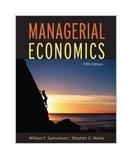The right tools to guide real decisions
When you're climbing a mountain, you have to carefully consider every step if you want to
reach your goal. You need to know how your tools will actually perform on the mountain. It
also helps to have a trusted guide who knows the way.
The same holds true in today's highly competitive, global business environments. The
decisions managers make are more complex and critical than ever before. You need to
understand how to use economic analysis techniques to make real business decisions.
When it comes to making real-life decisions based on sound economic analysis, there is no
better guide than Samuelson and & Marks's Managerial Economics, 5th Edition. Featuring
many detailed, real-world examples, as well as strong coverage of decision making under
uncertainty, game theory, and international topics, this practical text equips you with
the right tools you need to make smart decisions.
New in the Fifth Edition
Updated and revised chapters on making decisions under uncertainty (Chapters 8 and 9).
New discussions of behavioral economics, including such issues as bounded rationality,
sunk-cost fallacies, decision-making heuristics and biases, and the winner's curse.
Updated and expanded coverage of corporate incentives and governance.
Incorporates new developments in the areas of technological change, network economies, and
internet economics.
Updated applications and revised end-of-chapter problems.
Table of Contents
Chapter 1: Introduction to Economic Decision Making.
SECTION: DECISIONS WITHIN FIRMS.
Chapter 2: Optimal Decisions Using Managerial Analysis.
Chapter 3: Demand Analysis and Optimal Pricing.
Chapter 4: Estimating Demand.
Chapter 5: Forecasting.
Chapter 6: Production.
Chapter 7: Cost Analysis.
Chapter 8: Decision Making Under Uncertainty.
Chapter 9: The Value of Information.
SECTION II: COMPETING WITHIN MARKETS.
Chapter 10: Perfect Competition.
Chapter 11: Monopoly.
Chapter 12: Oligopoly.
Chapter 13: Game Theory and Competitive Strategy.
Chapter 14: Regulation, Public Goods, and Benefit-Cost Analysis.
SECTION III: DECISION-MAKING APPLICATIONS.
Chapter 15: Asymmetric Information and Organizational Design.
Chapter 16: Bargaining and Negotiating.
Chapter 17: Auctions and Competitive Bidding.
Chapter 18: Linear Programming.
Chapter 19: Capital Budgeting.
Making Investment Decisions.
Determining the Discount Rate.
Appendix to Chapter 19: Present Value Tables.
Answers to Odd-Nunbered Problems.
Index.
Table of Contents
William F. Samuelson is professor of economics and finance at Boston
University School of Management. He received his B.A. and Ph.D. from Harvard University.
His research interests include game theory, decision theory, bidding, bargaining, and
experimental economics. He has published a variety of articles in leading economics and
management science journals including The American Economic Review, the Quarterly Journal
of Economics, Econometrica, the Journal of Finance, Management Science, and Operations
Research. His teaching and research have been sponsored by the National Science Foundation
and the National Institute for Dispute resolution, among others. He is currently on the
editorial boards of the Journal of Economic Behavior and Organization and Group Decision
and Negotiation.
Stephen G. Marks is associate professor of law at Boston University. He
received his J.D., M.A., and Ph.D. from the University of California-Berkeley. He has
taught in the areas of managerial economics, finance, corporate law, and securities
regulation. his research interests include corporate governance, law and economics,
finance, and information theory. He has published his research in various law reviews and
in such journals as the American Economic Review, The Journal of Legal Studies, and The
Journal of Financial and Quantitative Analysis.
Hardback
919 pages
Księgarnia nie działa. Nie odpowiadamy na pytania i nie realizujemy zamówien. Do odwolania !.


